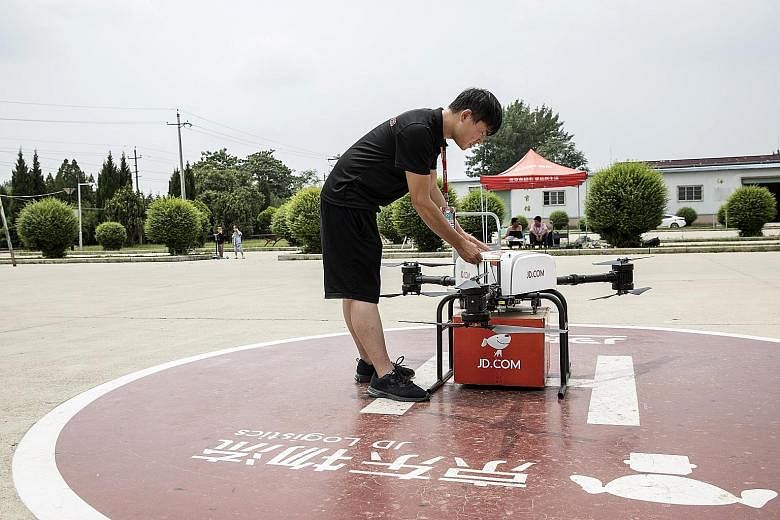BEIJING • The day after Chinese e-commerce giant JD.com's mid-year sale, a company drone took off from a playground in the city of Xi'an to deliver one of the orders in a football-sized box to a village in the mountains to the south.
The six-rotor craft is one of about 40 that JD.com designed to cut delivery times for items such as smartphones and food to remote areas where land transport is too expensive or slow.
JD.com is racing companies from across the world to develop unmanned aerial vehicles with the strength, range and reliability to deliver goods on a large scale and solve the expensive "last-mile" problem for couriers.
What sets China's efforts apart is its ability to assemble all the other parts needed for drone deliveries, including the regulations, infrastructure and the world's biggest e-commerce market.
And to make all those work together, it needs data.
So last year, the Civil Aviation Administration of China (CAAC) gave the nod to JD.com and SF Holding, the country's biggest express-delivery company, to start sending packages by drone in certain rural areas.
The idea is to build a network that includes large autonomous fixed-wing planes that take off from small airports or landing strips to ferry shipments between warehouses.
China's killer advantage is the market. The country has both the advanced drone technologies and millions of consumers living in remote areas that are hard to get to - sometimes impossible to get to - by truck.
China had more than 590 million "rural" residents at the end of last year, the statistics bureau says.
"People living in mountainous regions hardly accessible by ground transportation also have the right to shop," said a JD.com manager. "We are giving them the same shopping experience, same price, by flying drones."
The race for drone deliveries is being fuelled by competition between JD.com and rival Alibaba.
Alibaba's lighter business model means it relies on partners to make deliveries, but its logistics division Cainiao has partnered with Beihang Unmanned Aircraft System to develop cargo drones. One model being worked on by the drone company is capable of carrying a tonne of goods more than 1,500km.
Ele.me, Alibaba's food delivery arm, gained approval in May to test drones in a large industrial zone.
In the United States, the Department of Transportation in May selected 10 state, local and tribal governments to test commercial drones in partnership with companies including Intel, Uber Technologies and Qualcomm.
One company not in the trial is Amazon.com, whose Prime Air unit is a leader in drone delivery development. Amazon has been testing drone deliveries in the United Kingdom since 2016.
Drone use by JD.com and SF is still only a tiny fraction of their operations, but for the Chinese government, the technology offers a way to help alleviate poverty in rural areas and narrow the wealth gap with urban centres.
It could also make China a model for other governments looking to draft rules for the coming swarms of civil drones. In March, the CAAC released rules for commercial drones that require operators to apply for a licence for craft used for aerial spraying and imaging.
However, the rules do not apply to drones for deliveries or transporting passengers, for which the regulator is still collecting data.
Governments in other countries are also developing rules, but huge challenges remain.
In the US, regulators are trying to address how to create a low-level air-traffic system to ensure drones do not hit one another or traditional aircraft. Other problems include a standard for communicating with the craft, safety and privacy concerns.
BLOOMBERG

